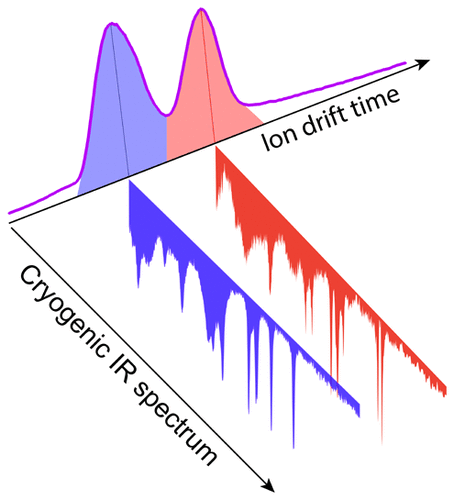当前位置:
X-MOL 学术
›
Acc. Chem. Res.
›
论文详情
Our official English website, www.x-mol.net, welcomes your feedback! (Note: you will need to create a separate account there.)
Combining Ion Mobility and Cryogenic Spectroscopy for Structural and Analytical Studies of Biomolecular Ions
Accounts of Chemical Research ( IF 18.3 ) Pub Date : 2018-05-10 00:00:00 , DOI: 10.1021/acs.accounts.8b00133 Michael Z. Kamrath 1 , Thomas R. Rizzo 1
Accounts of Chemical Research ( IF 18.3 ) Pub Date : 2018-05-10 00:00:00 , DOI: 10.1021/acs.accounts.8b00133 Michael Z. Kamrath 1 , Thomas R. Rizzo 1
Affiliation

|
Ion mobility spectrometry (IMS) has become a valuable tool in biophysical and bioanalytical chemistry because of its ability to separate and characterize the structure of gas-phase biomolecular ions on the basis of their collisional cross section (CCS). Its importance has grown with the realization that in many cases, biomolecular ions retain important structural characteristics when produced in the gas phase by electrospray ionization (ESI). While a CCS can help distinguish between structures of radically different types, one cannot expect a single number to differentiate similar conformations of a complex molecule. Molecular spectroscopy has also played an increasingly important role for structural characterization of biomolecular ions. Spectroscopic measurements, particularly when performed at cryogenic temperatures, can be extremely sensitive to small changes in a molecule’s conformation and provide tight constraints for calculations of biomolecular structures. However, spectra of complex molecules can be heavily congested due to the presence of multiple stable conformations, each of which can have a distinct spectrum. This congestion can inhibit spectral analysis and complicate the extraction of structural information. Even when a single conformation is present, the conformational search process needed to match a measured spectrum with a computed structure can be overwhelming for peptides of more than a few amino acids, for example.
中文翻译:

结合离子淌度和低温光谱进行生物分子离子的结构和分析研究
离子迁移谱(IMS)已成为生物物理和生物分析化学中的重要工具,因为它具有根据碰撞截面(CCS)分离和表征气相生物分子离子的结构的能力。随着人们认识到,在许多情况下,当通过电喷雾电离(ESI)在气相中产生生物分子离子时,生物分子离子仍保持重要的结构特征,其重要性日益提高。尽管CCS可以帮助区分根本不同类型的结构,但不能指望一个数字就能区分复杂分子的相似构象。分子光谱学在生物分子离子的结构表征中也起着越来越重要的作用。光谱测量,特别是在低温下进行的测量,对分子构象的微小变化极为敏感,并为计算生物分子结构提供了严格的约束条件。但是,由于存在多个稳定的构象,复杂分子的光谱可能会严重拥挤,每个构象都可能具有不同的光谱。这种拥塞会抑制频谱分析并使结构信息的提取复杂化。即使存在单个构象,例如,对于多于几个氨基酸的肽来说,将测得的光谱与计算的结构进行匹配所需的构象搜索过程也会使您不堪重负。由于存在多个稳定构象,复杂分子的光谱可能会严重拥挤,每个构象都可能具有不同的光谱。这种拥塞会抑制频谱分析并使结构信息的提取复杂化。即使存在单个构象,例如,对于多于几个氨基酸的肽来说,将测得的光谱与计算的结构进行匹配所需的构象搜索过程也会使您不堪重负。由于存在多个稳定构象,复杂分子的光谱可能会严重拥挤,每个构象都可能具有不同的光谱。这种拥塞会抑制频谱分析并使结构信息的提取复杂化。即使存在单个构象,例如,对于多于几个氨基酸的肽来说,将测得的光谱与计算的结构进行匹配所需的构象搜索过程也会使您不堪重负。
更新日期:2018-05-10
中文翻译:

结合离子淌度和低温光谱进行生物分子离子的结构和分析研究
离子迁移谱(IMS)已成为生物物理和生物分析化学中的重要工具,因为它具有根据碰撞截面(CCS)分离和表征气相生物分子离子的结构的能力。随着人们认识到,在许多情况下,当通过电喷雾电离(ESI)在气相中产生生物分子离子时,生物分子离子仍保持重要的结构特征,其重要性日益提高。尽管CCS可以帮助区分根本不同类型的结构,但不能指望一个数字就能区分复杂分子的相似构象。分子光谱学在生物分子离子的结构表征中也起着越来越重要的作用。光谱测量,特别是在低温下进行的测量,对分子构象的微小变化极为敏感,并为计算生物分子结构提供了严格的约束条件。但是,由于存在多个稳定的构象,复杂分子的光谱可能会严重拥挤,每个构象都可能具有不同的光谱。这种拥塞会抑制频谱分析并使结构信息的提取复杂化。即使存在单个构象,例如,对于多于几个氨基酸的肽来说,将测得的光谱与计算的结构进行匹配所需的构象搜索过程也会使您不堪重负。由于存在多个稳定构象,复杂分子的光谱可能会严重拥挤,每个构象都可能具有不同的光谱。这种拥塞会抑制频谱分析并使结构信息的提取复杂化。即使存在单个构象,例如,对于多于几个氨基酸的肽来说,将测得的光谱与计算的结构进行匹配所需的构象搜索过程也会使您不堪重负。由于存在多个稳定构象,复杂分子的光谱可能会严重拥挤,每个构象都可能具有不同的光谱。这种拥塞会抑制频谱分析并使结构信息的提取复杂化。即使存在单个构象,例如,对于多于几个氨基酸的肽来说,将测得的光谱与计算的结构进行匹配所需的构象搜索过程也会使您不堪重负。



























 京公网安备 11010802027423号
京公网安备 11010802027423号